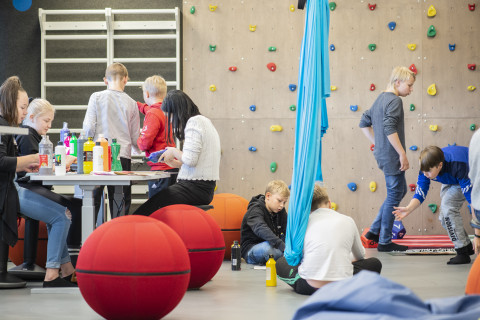School architecture has a major impact on the school soundscape and, consequently, on the well-being of pupils and teachers alike, according to a new study from the University of Eastern Finland exploring the soundscapes of two modern schools. The researchers analysed sounds audible in the school premises and produced by technological devices. By interviewing teachers, the researchers also wanted to address how the school soundscape affects learning.
“School architecture affects both the school soundscape, and the way teachers organise their teaching,” says University Researcher Elina Hytönen-Ng.
Perfect silence is no longer the goal
Primary schools have a unique, yet very diverse soundscape consisting of sounds made by the people working and studying in the school, sounds produced by different technological devices, and sounds coming from outside the school. The soundscape is produced by people as they talk and move about in the school, and it is also encountered more passively through sounds coming from electrical appliances, for example.
A school design favouring open-plan classrooms encouraged collaboration in learning; however, open-plan classrooms and their soundscapes do not always support children’s needs.
“Our findings clearly indicate that school design should better consider the needs and limitations of different learners.”
Soundscapes often go unnoticed, although they play a major role in how we experience strain.
Elina Hytönen-Ng
University Researcher
For pupils and teachers spending a large part of their day in the school, the school soundscape is an important factor of well-being. Well-being, on the other hand, has an impact on children’s school performance, which also has far-reaching implications for their future. Teachers, on the other hand, make their careers inside the school building, and sometimes their careers span over several decades.
“Our research group also wanted to explore how teachers’ coping and well-being at work could be better supported. Soundscapes often go unnoticed, although they play a major role in how we experience strain,” Hytönen-Ng notes.
Teachers interviewed for the study emphasised that the sounds of talking and doing constitute part of the modern conception of learning, which highlights interaction and learning by doing.
“Perfect silence is no longer the goal, and the sounds of learning are well-tolerated,” Postdoctoral Researcher Kaisa Pihlainen says.
Research article:
Hytönen-Ng, Elina, Pihlainen, Kaisa, Ng, Kwok ja Kärnä Eija. 2022. ”Sounds of learning: Soundscapes - teacher perceptions of acoustic environments in Finland's open plan classrooms.” Issues in Educational Research, 32(4), 2022.




